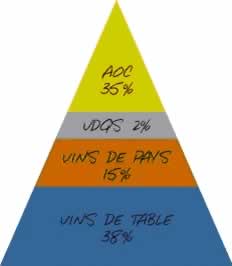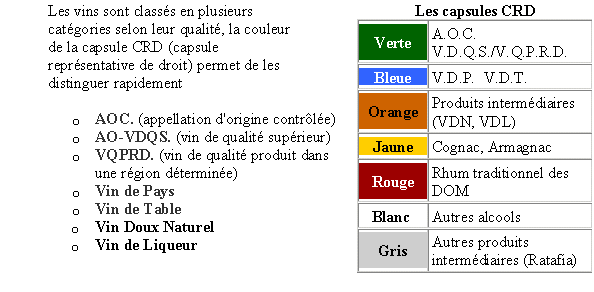THE CLASSIFICATION OF WINES BY CATEGORY
In France and Europe, wine is regulated by the state to protect the consumer and the winemaker.
Since 1973, French legislation has only recognized the classification below. Quality guaranteed by
The appellations.

Because of the diversity of grape varieties and terroirs, France is certainly the country in the world offering the richest and most varied wine production. Wine growers' know-how further amplifies the phenomenon. An individual hierarchical classification proves impossible, Each wine can be chosen according to the moment, the menu, the circumstances, and the preferential tastes of each. French legislation classifies the wines of France into two large families themselves divided categories:
VQPRD: Quality wine produced in defined areas
AOC: Appellation d'Origine Contrôlée
AO-VDQS: Designation of Origin-Wine of Superior Quality
Table wines
O Table wines themselves
O Country wines or table wines with a geographical indication
O Natural Sweet Wines
O Liqueur wines
Each of these categories of wine is governed by production rules strictly defined by Community rules and supplemented at national level: Rules concerning the production potential:Control of vine plantations:
(A) a ban on new planting, except in the case of reparcelling, experimentation, the cultivation of mother graft vines or for family consumption.
(B) possible replanting rights for vine replacement and under strictly defined conditions.Control of grape varieties: Depending on the category of the wine produced and the region of production, only certain specific grape varieties may be grown.Control of cultivation practices and Of the treatments that can be carried out at the vineyard.Rules concerning wine:
Obligation to report harvest to the Customs Department: comparison of the quantities of wines produced, the category of wine claimed according to the area of production, the area declared, the yield allowed and the grape varieties used. Compliance with specific production criteria: depending on the category of wine produced, a minimum of conditions must be met in terms of yield, grape varieties, authorized oenological processes, analytical standards and breeding conditions.
Compliance with an official approval procedure: this procedure guarantees the origin of the wine produced by combining control of production criteria and organoleptic control.
Obligation of traceability by maintaining a material compatibility and use of accompanying documents during each displacement of the product. The mention of the category is obligatory on the label of any bottle, as well as the capacity (in general 75cl) and the degree / In the various categories, the name of the establishment which has carried out the bottling, whether it is a trader or an owner, is also obligatory. In this case, mention is made of: bottled at the In the castle. Otherwise, it is a wine of merchant. The indication of the vintage is not compulsory for the AOC and the AOVDQS. It is prohibited for the VDP and the table wines.1 - DEFINITION
The designation of origin is the name of a country, locality or region used to designate a product originating from it, the qualities and characteristics of which are due to the geographical environment including natural factors and factors humans. (Official text). Therefore, in order for the winegrower to be entitled to the appellation, his wine must meet standards that affect the geographical area, the area of production, the grape varieties used, the title of alcoholometry, the yield per hectare , Conditions of cultivation and vinification. This is I.N.A.O. Which is responsible for controlling all of these points and giving the controlled designation of origin. Other appellations are based on texts from the European Community.2 – LES APPELLATIONS et LA COULEUR DES CAPSULES
3 – OBTAINING A A.O.C
This is I.N.A.O. Which defines appellations in France. It also monitors and monitors it. The process involves a number of steps that can be summarized as follows:
Trade union application -> Services of the I.N.A.O. -> opinion of the regional committee and drafting of a report-> agreement or refusal-> if yes, commission and verification by the I.N.A.O.-> publication in the official gazette.
The regulation of A.O.C:
Once an A.O.C has been defined, its boundaries delimited, other rules
Are used to define the following parameters:
Maximum output
Grape varieties can be cultivated
The minimum and sometimes maximum alcoholic level
The number of vines planted per hectare
Soil amendment
The use of fertilizers
The techniques of size
The chaptalisation (addition of sugar in the must)
The list of authorized products in vinification
The treatment of wines
Movements
Defined production area
Defined cultural practices
Maximum output
Grape varieties
Analytical Criteria
GENERAL CONDITIONS FOR THE PRODUCTION OF WINES
AOC (Protected Designation of Origin)
The appellation of these wines stamped AOC is fixed by decree comes from a strictly delimited terroir (concept of terroir and doc cutting of the area of production at the level of the plot of vine.) And corresponds to very precise standards: origin , Grape varieties, viticulture, vinification, natural alcoholisation and yield per hectare. It is the most regulated wine. It satisfies the conditions of production determined by the INAO and formalized by decrees of production. The areas of registered designation of origin are very restricted and delimited very precisely.These wines also include many generic appellations covering a region that appellations restricted To one or more communes and even to a parcel. The vineyard must be noble. The yield is legislated: if the yield is exceeded, the wine can be decommissioned. To obtain this yield, it is forbidden to water and the size of the vines is regulated. The vinification techniques are cooled and Are the same in each AOCUn minimum degree for each designation is set. The chaptalisation is either controlled or prohibited in the South. Each year, it is questioned during a tasting by the experts of the INAO at the request of the winegrowers who produce them.All wines claiming AOC Are subjected to an analytical and organoleptic examination. They are officially approved by the INAO.On the label, appears, Appellation (Origine) controlled.Only, Champagne is exempt from this mention, the appellation "Champagne" Implying the appellation AOC. On the other hand, the name of the farmer, his status and his professional number must appear. When the name of a grape variety is indicated, it means that there is no assembly and the wine must come from one and the same variety. (Ex: most of Alsace).
Les AO-VDQS ( Appellation d’Origine-Vin De Qualité Supérieure )
Also meet certain standards and production is strictly regulated and controlled by the INAO. These standards are less draconian at technical level, and fixed by decree. It is the anti-chamber of the A.O.C. and almost all the V.D.Q.S. Are promoted A.O.C. though they are fewer and fewer. The cultivation areas are smaller and the encrepation is restricted. The degree of alcohol is fixed for each V.D.Q.S. The label must bear the mention in full letters, as well as the origin justifying the name. The address where the bottling took place must be included. VDQS can be proprietary wines or trading wines. They must count at least 10 to 15 years to obtain the passage after an initial application. They are an intermediate category between the wines of the countries and the AOC. The production is regulated and controlled by the INAO and provides for the issuance of a label by the concerned wine trade union.
Les VDP (Vin de Pays )
It is the higher category of table wines because they are more free on the choice of grape varieties, yields and practices.These are Table wines personalized by a known territorial provenance (department), with a production defined by decree. This category was created in 1968 for certain table wines identified by the indication of provenance. The vines must comply with certain rules. The rules defining them include the geographical or regional identity, certain grape varieties selected by decrees, the yield per hectare maximum .. The minimum degree of alcohol must be 10 degrees. It must therefore pass a test of tasting. Label must mention "country wine" followed by the name of the department. A large number of French departments (about forty) produce wines from countries.
The appellation "Wines of Countries" authorizes the producer to sell his wine as "table wine", only a part of which will be declared "country wine". Moreover, the regulation of "wines of countries" results in more flexibility regarding the assemblies. A trader can thus buy a whole panoply of different grape varieties, assemble them and sell them for example under the name "Vin de Pays d'Oc". Among other things, this category allows A.O.C wine growers to develop new styles of wine. They are authentic wines, living reflection of their terroir, which are pleasant to drink generally young.
There are three zones or categories of "country wines":
· The wines of countries with a departmental denomination which come from all the French departments producing wine The number of departments is currently 44: "Wine of the country of the Gard" "Wine of Country of the Aude" «Wine of Pays de l ' Ardèche "... Its production is governed by the general decree of 1 September 2000.
· Local wines that often bear the name of a valley or a site. There are about 95 of them. These are wines from countries, small areas and are the subject of a decree of production. The labels must mention the name of the commune of origin, such as the country wine of the Val d'Orbieu. ..
· Wines from countries with a regional denomination or large areas are named as a geographical area that covers several departments.
These country wines are 5:
Wines from the Garden of France (Loire Valley)
Wines from the counties of Tolosan (Midi Pyrenees)
Wines from Pays d'Oc (Languedoc Roussillon)
Wines from the counties Rhôdaniens (Rhône Alpes)
Country wines Porte des Méditerranées (Provence Alpes Cotes d'Azur).
These three categories of country wines represent about 140 denominations in pink and red whites.
The labeling regulations prohibit the use of the terms "Château" or "Clos", reserved for A.O.C. The term "Domaine" may however appear on the label. The appellation "Vin de Pays" will be granted after wine tasting by a commission.
These wines from countries are subject to a specific approval procedure combining analytical and organoleptic control and are officially approved by ONIVINS (Office National Interprofessionnel des Vins)
Les VDT (Vin de Table)
Table wines are entitled to the description "French table wine" if they are of exclusively French origin (wines from the same region or wines from different regions. From all sources, allowed to be blended (popularly Called "coupage." Thus all wines that do not meet the above criteria or those whose producers have not applied for accreditation to participate in them.These wines are often obtained from highly productive vines. Bottles must be marked on the label.) The vintage is forbidden The only mandatory information is the degree of alcohol and the denomination "mixture of wines from different countries of the European Community. They do not mention any geographical origin. However, they may bear the words "table wine of France". Vintage and often sold under a trademark. They are produced mainly in the South of France and assembled with other wines from countries of the European Community.
Les Vins de Cépage
This name is not official. It simply indicates that the wine comes from a single grape. Appreciated by consumers, especially foreigners, this precision is increasingly brought on the labels of wines of mono-grape countries .
In this category one can find wines produced from a single grape variety, displayed on the label but their geographical origin must always be included. The wines of grape varieties are in France essentially wines of countries. (The mention of the variety is exceptional in the case of AOC except as in Alsace).
60% of the wines come from cooperatives.
Most of the wines from the region's countries are produced.
Natural Sweet Wines
VDNs are not subject to the legal rules of alcohol. But they are subject to the same production rules for AOCs. They are said to be mutated wines, that is to say, the fermentation is stopped suddenly by adding alcohol. They are also subject to the production rules for AOCs.
They are mutated wines, that is, the fermentation is stopped by the addition of alcohol. Before the mutation, they are vinified as red wines if they are red VDN: banyuls, Maury, rasteau, porto ... they are vinified as white wines if it is white VDN (Muscat)
Wines of Liqueur
They are obtained from grape must either wine or from the mixture of these products in part fermented. An article stipulates the origin of varieties of precise vines to create the liqueur wines.Natural alcoholic strength must not be less than 12% .It is said that the must or the cognac which is used for its production must come from the same wine company.Ex: Pineau des Charentes (18-22% alcoholic strength) It is specified that the mout or the Cognac used in its development must come from the same vineyard. Pine must have an alcohol content of 16-22%. We also specify the yield the grape varieties and the duration of aging in barrels. We distinguish: Pineau des Charentes, ratafia de Bourgogne, macvin du Jura, and floc de Gascogne

